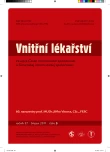External factors catalyzing the development of tumours or providing protection against them
Authors:
J. Fiala 1; J. Vorlíček 2; Z. Mechl 3; Z. Adam 3
Authors‘ workplace:
Ústav preventivního lékařství Lékařské fakulty MU Brno, přednostka prof. MUDr. Zuzana Derflerová Brázdová, DrSc.
1; Masarykův onkologický ústav Brno, ředitel prof. MUDr. Jiří Vorlíček, CSc.
2; Interní hematoonkologická klinika Lékařské fakulty MU a FN Brno, pracoviště Bohunice, přednosta prof. MUDr. Jiří Mayer, CSc.
3
Published in:
Vnitř Lék 2011; 57(3): 261-284
Category:
60th birthday of prof. Mudr. Jiřího Vítovce, CSc, FESC
Overview
The number of malignant diseases increases and the question is why. Why is there an increasing incidence of certain cancers and why an increasing number of people dies from them? We do not have a clear answer to these questions. We just know that a development of cancer depends on certain internal predispositions as well as external conditions. We are unable to change our genetic predisposition but we are able, to some extent, influence the intensity of external factors. This paper summarizes information on the effects of external environment on the development of malignant diseases.
Key words:
malignant diseases – carcinogens – physical activity – smoking – human papillomavirus
Sources
1. Doll R, Peto R. The causes of cancer: quantitative estimates of avoidable risks of cancer in the United States today. J Natl Cancer Inst 1981; 66: 1191–1308.
2. Danaei G, Vander Hoorn S, Lopez AD et al. Comparative Risk Assessment collaborating group (Cancers). Causes of cancer in the world: comparative risk assessment of nine behavioral and environmental risk factors. Lancet 2005; 366: 1784–1793.
3. Martin-Moreno JM, Soerjomataram I, Magnusson G. Cancer causes and prevention: A condensed appraisal in Europe in 2008. Eur J Cancer 2008; 44: 1390–1403.
4. Albreht T, McKee M, Alexe DM et al. Making progress against cancer in Europe in 2008. Eur J Cancer 2008; 44: 1451–1456.
5. Clapp RW, Howe GK, Jacobs MM. Environmental and occaupational causes of cancer: A call to act on what we know. Biomed Pharmacother 2007; 61: 631–639.
6. Coleman MP, Alexe DM, Albreht T et al (eds). Responding to the challenge of cancer in Europe. Ljubljana: Institute of Public Health of the Republic of Slovenia 2008.
7. Frieden TR, Myers JE, Krauskopf MS et al. A public health approach to winning the war against cancer. Oncologist 2008; 13: 1306–1313.
8. Soerjomataram I, deVries E, Pukkala E et al. Excess of cancers in Europe: a study of eleven major cancers amenble to lifestyle change. Int J Cancer 2007; 120: 1336–1343.
9. Gandini S, Botteri E, Iodice S et al. Tobaco smoking and cancer: A meta-analysis. Int J Cancer 2008; 122: 155–164.
10. IARC Working Group on the Evaluation of Carcinogenic Risks to Humans. Tobacco smoke and involuntary smoking. IARC Monogr Eval Carcinog Risks Hum 2004; 83: 1–1438.
11. Secretan B, Straif K, Baan R et al. WHO International Agency for Research on Cancer Monograph Working Group. A review of human carcinogens – Part E: tobacco, areca nut, alcohol, coal smoke, and salted fish. Lancet Oncology 2009; 10: 1033–1034.
12. Heeschen C, Jang JJ, Weiss M et al. Nicotine stimulates angiogenesis and promotes tumor growth and atherosclerosis. Nat Med 2001; 7: 833–839.
13. Davis R, Rizwani W, Banrjee S et al. Nicotine promotes tumor growth and metastasis in mouse models of lung cancer. PLoS One 2009; 4: e7524.
14. Garces YI, Yang P, Parkinson J et al. The relationship between cigarette smoking and quality of life after lung cancer diagnosis. Chest 2004; 126: 1733–1741.
15. Schuller HM, Plummer HK 3rd, Jull BA. Receptor-mediated effects of nicotine and its nitrosated derivate NNK on pulmonary neuroendocrine cells. Anat Rec A Discov Mol Cell Evol Biol 2003; 270A: 51–58.
16. World Cancer Research Fund/American Institute for Cancer Research: Food, Nutrition, Physical Activity, and the Prevention of Cancer: a Global Perspective. Washington DC: AICR 2007.
17. Kushi LH, Byers T, Doyle C et al. American Cancer Society 2006 Nutrition and Physical Activity Guidelines Advisory Committee. American Cancer Society Guidelines on nutrition and physical activity for cancer prevention: Reducing the risk of cancer with healthy food choices and physical activity. CA Cancer J Clin 2006; 56: 254–281.
18. Brousset P. Is the Epstein-Barr virus infection relevant in lymphomagenesis? Hum Pathol 2002; 33: 143–145.
19. Mensinga TT, Speijers GJ, Meulenbelt J. Health implications of exposure to environmental nitrogenous compounds. Toxicol Rev 2003; 22: 41–51.
20. De Roos AJ, Ward MH, Lynch CF et al. Nitrate in public water supplies and the risk of colon and rectum cancers. Epidemiology 2003; 14: 640–649.
21. Sandor J, Kiss I, Farkas O et al. Association between gastric cancer mortality and nitrate content of drinking water: ecological study on small area inequalities. Eur J Epidemiol 2001; 17: 443–447.
22. Türkdoğan MK, Testereci H, Akman N et al. Dietary nitrate and nitrite levels in an endemic upper gastrointestinal (esophageal and gastric) cancer region of Turkey. Turk J Gastroenterol 2003; 14: 50–53.
23. van Loon AJ, Botterweck AA, Goldbohm RA. Intake of nitrate and nitrite and the risk of gastric cancer: a prospective cohort study. Br J Cancer 1998; 78: 129–135.
24. Ward MH, Mark SD, Cantor KP et al. Drinking water nitrate and the risk of non-Hodgkin’s lymphoma. Epidemiology 1996; 7: 465–471.
25. Ward MH, Mark SD, Cantor KP et al. Non-Hodgkin’s lymphoma and nitrate in drinking water. J Epidemiol Community Health 2000; 54: 772–773.
26. Weyer PJ, Cerhan JR, Kross BC et al. Municipal drinking water nitrate level and cancer risk in older women: the Iowa Women’s Health Study. Epidemiology 2001; 12: 327–338.
Labels
Diabetology Endocrinology Internal medicineArticle was published in
Internal Medicine

2011 Issue 3
Most read in this issue
- Microalbuminuria. From diabetes to cardiovascular risk
- External factors catalyzing the development of tumours or providing protection against them
- Internal medicine and cardiology, internists and cardiologists
- Left ventricular end-systolic wall stress during antihypertensive treatment
